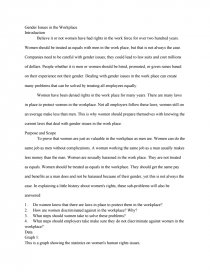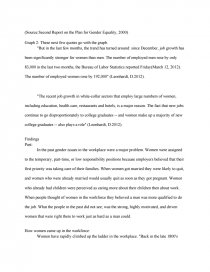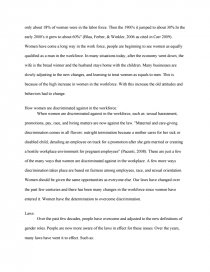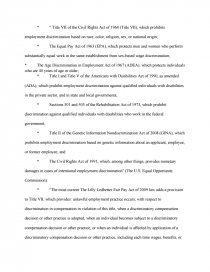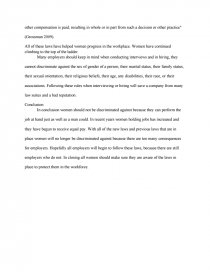Gender Issues in the Workplace
Essay by bsterner1984 • May 14, 2014 • Essay • 1,394 Words (6 Pages) • 1,789 Views
Gender Issues in the Workplace
Introduction
Believe it or not women have had rights in the work force for over two hundred years. Women should be treated as equals with men in the work place, but that is not always the case. Companies need to be careful with gender issues; they could lead to law suits and cost millions of dollars. People whether it is men or women should be hired, promoted, or given raises based on their experience not their gender. Dealing with gender issues in the work place can create many problems that can be solved by treating all employees equally.
Women have been denied rights in the work place for many years. There are many laws in place to protect women in the workplace. Not all employers follow these laws; women still on an average make less than men. This is why women should prepare themselves with knowing the current laws that deal with gender issues in the work place.
Purpose and Scope
To prove that women are just as valuable in the workplace as men are. Women can do the same job as men without complications. A woman working the same job as a man usually makes less money than the man. Women are sexually harassed in the work place. They are not treated as equals. Women should be treated as equals in the workplace. They should get the same pay and benefits as a man does and not be harassed because of their gender, yet this is not always the case. In explaining a little history about women's rights, these sub-problems will also be answered:
1. Do women know that there are laws in place to protect them in the workplace?
2. How are women discriminated against in the workplace? Why?
3. What steps should women take to solve these problems?
4. What steps should employers take make sure they do not discriminate against women in the workplace?
Data
Graph 1:
This is a graph showing the statistics on women's human rights issues.
(Source:Second Report on the Plan for Gender Equality, 2000)
Graph 2: These next few quotes go with the graph.
"But in the last few months, the trend has turned around: since December, job growth has been significantly stronger for women than men. The number of employed men rose by only 83,000 in the last two months, the Bureau of Labor Statistics reported Friday(March 12, 2012). The number of employed women rose by 192,000" (Leonhardt, D.2012).
"The recent job growth in white-collar sectors that employ large numbers of women, including education, health care, restaurants and hotels, is a major reason. The fact that new jobs continue to go disproportionately to college graduates -- and women make up a majority of new college graduates -- also plays a role" (Leonhardt, D.2012).
Findings
Past:
In the past gender issues in the workplace were a major problem. Women were assigned to the temporary, part-time, or low responsibility positions because employers believed that their first priority was taking care of their families. When women got married they were likely to quit, and women who were already married would usually quit as soon as they got pregnant. Women who already had children were perceived as caring more about their children then about work. When people thought of women in the workforce they believed a man was more qualified to do the job. What the people in the past did not see; was the strong, highly motivated, and driven women that were right there to work just as hard as a man could.
How women came up in the workforce:
Women have rapidly climbed up the ladder in the workplace. "Back in the late 1800's only about 18% of women were in the labor force. Then the 1900's it jumped to about 30%.In the early 2000's it grew to about 60%" (Blau, Ferber, & Winkler, 2006 as cited in Carr 2009). Women have come a long way in the work force, people are beginning to see women as equally qualified as a man in the workforce. In many situations today, after the economy went down, the wife is the bread winner and the husband stays home with the children. Many businesses are slowly adjusting to the new changes, and learning to treat women as equals to men. This is because of the high increase in women in the workforce. With this increase the old attitudes and behaviors had to change.
How women are discriminated against in the workforce:
When women are discriminated against in the workforce, such as: sexual harassment, promotions, pay, race, and hiring matters are now against the law. "Maternal and care-giving discrimination comes in all flavors: outright termination because a mother cares for her sick or disabled child; derailing an employee on track for a promotion after she gets married or creating a hostile workplace environment for pregnant employees" (Pacenti, 2008). These are just a few of the many ways that women are discriminated against in the workplace. A few more ways discrimination takes place are based on fairness among
...
...
